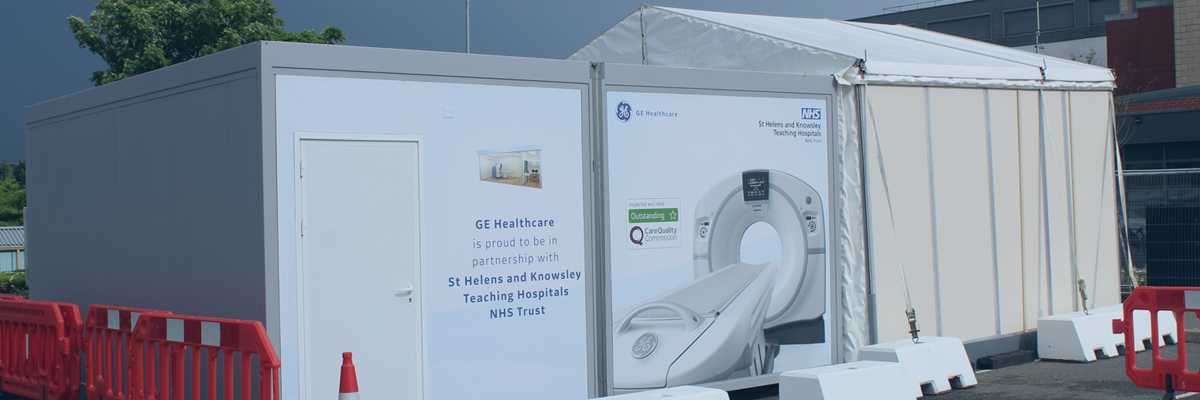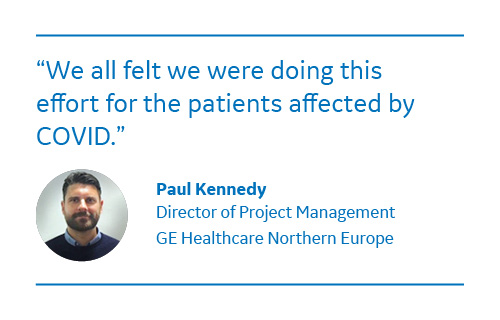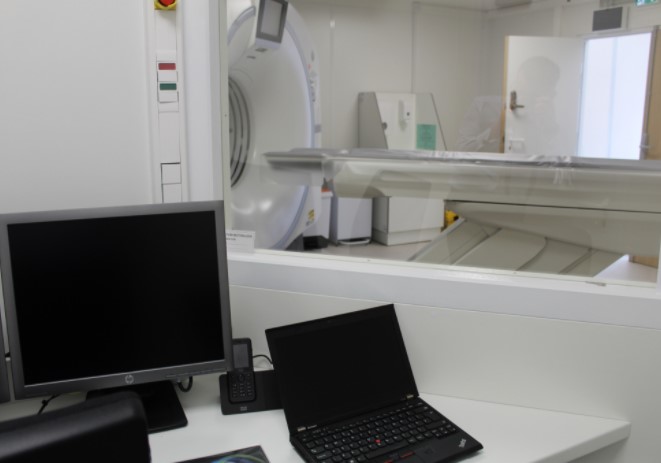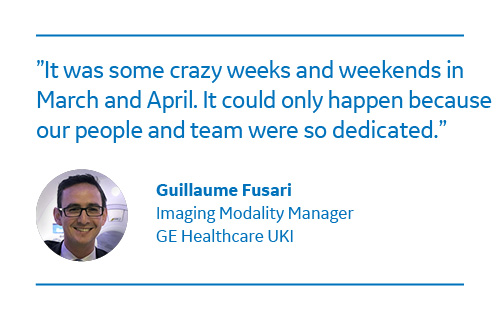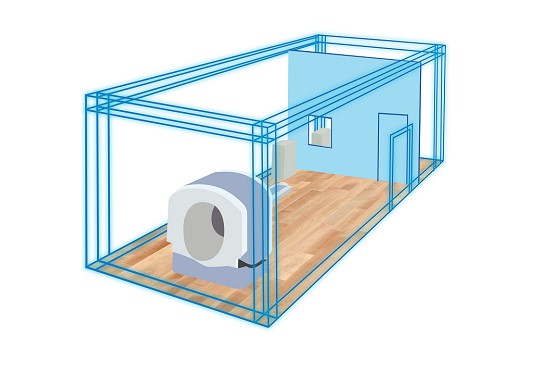CT-in-a-box installed at St Helens and Knowsley Teaching Hospitals NHS Trust in the UK.
“At that time, everybody was asking themselves what to expect, how many patients would need a CT scan and how long the COVID-wave would be exactly”
Most people that have seen or been examined in a CT scanner will recognize that it is not exactly the type of machinery that comes to your doorstep, delivered in a box. It seems far too big, bulky and heavy – and it needs X-ray to function.
But ‘CT-in-a-box’ was in fact the name of that type of mobile and ready-to-use CT solution requested by NHS England in the middle of March 2020 when the COVID-19 pandemic hit UKI. And GE Healthcare soon began to deliver mobile CT units, 18 of them in total, the first one in April. And in fairly big ‘boxes’.
“At that time the NHS, like everybody else, was asking themselves what to expect, how many patients would need a CT scan and how would the COVID wave last, and if the hospitals would be able to cope with the demand,“ recalls Guillaume Fusari, Imaging Modality Manager at GE Healthcare in the UK and Ireland.
“In order to be prepared, the NHS set up a series of temporary field hospitals, named Nightingale hospitals, to provide cover for the projected increase in patients. These hospitals were set up in very different places, in the middle of nowhere in the countryside and in conference centers. But they all needed a mobile CT solution to be placed close by, on a lawn or in a car park, that could be turned on and be ready for use. The same was true for many existing hospitals that simply had no room for installing an additional CT scanner.”
“The initial weeks leading into the COVID-19 outbreak created uncertainty about how to continue to offer outpatient radiology services in a way that was safe. Somerset Foundation Trust was offered an opportunity to acquire an additional CT scanner and we chose GE. The decision was taken to site the scanner at Bridgwater Community Hospital (BCH). This was the first time we’ve sited a CT scanner in the community, but GE and community estates team worked together to quickly plan for the scanner’s arrival. Within only a few weeks the scanner was sited and became operational. This facility has meant that we can offer CT scanning away from the acute hospital which has given some anxious patients additional reassurance," said Adam Turner, Operational Manager of Radiology at Taunton & Somerset NHS Foundation.
"The scan box itself provides a scan room size to rival most departmental scanners and has allowed us to maintain scanning, independent from the main Radiology department. The GE installation team worked hard to get the scanner installed as quickly as possible and were able to make all necessary adjustments to tailor the box to the needs of Somerset FT,” said Adam Turner.
“It was a learning process for everyone involved.”
A CT scan combines a series of X-ray images taken from different angles around a patient’s body and uses computer processing to create cross-sectional images of the bones, blood vessels and soft tissues inside the body. As such, CT-scans are very helpful, if not essential, for the diagnosis and the management of patients with suspected or known COVID-19 infection.
The first agreement with the NHS stated that GE Healthcare should have delivered all 18 CT-scanners by end of June. But as the COVID situation developed during the first months, the NHS decided to push parts of the delivery.
“It was a learning process for everyone involved,” explains Paul Kennedy, Director of Project Management at GE Healthcare in Northern Europe. As head for the GE project managers who manage customer facing installation projects, Paul was ultimately responsible for designing the packaged and mobile CT-solution that would fit the best with NHS’s needs. Not surprisingly, the NHS decided for the fastest model to implement.
Inside the CT in a box at St Helens and Knowsley Teaching Hospitals NHS Trust.
“The first ‘boxes’ delivered weren’t the same as the last ones.”
“As the NHS was learning more about COVID, they came back to us with additional requirements, for example about safety standards, things like infection control and hygiene procedures, and so we tweaked the design of the boxes. We also kept expanding the original boxes with things like ramps and patient waiting areas. So, the fact that the NHS was slowing down a bit in terms of when they needed all the CT scanners gave us time to keep improving the box-concept and the overall design. The first ‘boxes’ delivered were not the same as the last ones.”
The ongoing refinement of the CT-in-a-box concept also involved the pre-installation work needed for setting up a CT scanner, like taking care of connection to electricity and water:
“We knew that if we threw these kinds of problems at the NHS, it could go 18 different ways and eventually slow down the pace of installations. And so, the box-concept, meant that we could deliver a mobile and ready-to-use CT quickly – going beyond delivering just the CT itself,” adds Paul Kennedy.
“It was some crazy weeks and weekends in March and April.”
Meanwhile it was Stephen Cropper UKI Imaging Sales Director responsibility for driving the communication with NHSE for weeks and even over nights and weekends and Guillaume Fusari’s responsibility to build and maintain a strong communication with the customer. He and Steve worked as duo to balance the expectations of the NHS with GE Healthcare’s supply chain and specialists. It wasn’t a period with a regular 9-5 job.
“It was some crazy weeks and weekends in March and April. It could only happen because our people and team were so committed and dedicated,” says Guillaume and is seconded by Paul:
“I agree. This period and this kind of request, I can’t think of anything that we have responded to as quickly and as creatively as to this before. We often get asked to come up with solutions for different needs and scenarios, but in terms of speed and scale this was definitely something I’ve never come across before.”
“I think we all felt we were doing this effort for the patients affected by COVID.”
The concept of delivering a CT scanner in ‘a box’ originates from GE Healthcare in China where the first outbreak of COVID-19 was seen. But that didn’t mean that is was a simple copy-paste to a European context.
“We needed to go out and find the right local European providers and suppliers in order to build the complete systems. Excellent teamwork made it possible for us to succeed, for sure. But if I should point out one particular important individual, it would Francois Meignan. He was simply fantastic in helping us work with the vendor and operationalize the design and production locally in France. He was a great support throughout the whole project, it would have been difficult without him,” Paul Kennedy says and continues:
“No doubt the amount of work was phenomenal for a period, but it was the same for all of us. In the middle of a crisis, we felt we needed to do this – for ourselves, for the company, for the NHS. But in the end, we were doing this for the patients affected by COVID.“

